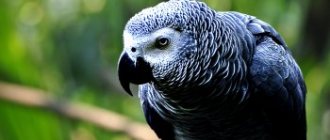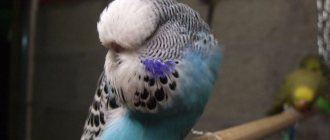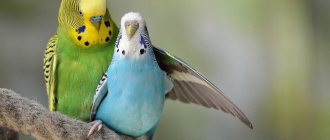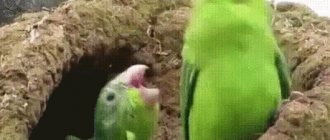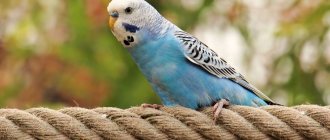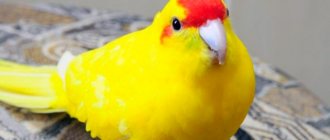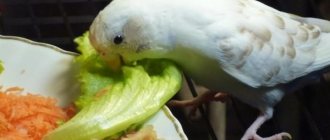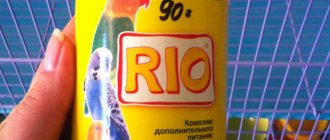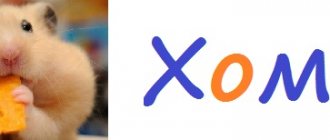In its natural habitat, that is, in Australia and on the islands adjacent to the mainland, the bird feeds on seeds, greens and fruits. The diet of birds at home is similar: grain feed and accompanying additives to replenish vitamins.
Let's find out what birds eat, what foods are of greatest interest to the parrot, and what budgerigars like.
What do parrots eat in the wild?
It is important to know what parrots and other small birds eat in their natural environment in order to provide them with everything they need at home. Wild budgerigars are nomadic birds that are found free-ranging in the arid regions of Australia.
They choose meadows and forested regions, and in rainy times they visit both farmland and suburbs. The regions where they live are very arid, so parrots may not drink water for a long time even in captivity.
In nature, small birds get:
- seeds of terrestrial plants, shrubs and trees;
- kangaroo grass seeds;
- bark of trees and shrubs;
- Exotic fruits.
In nature, parrots find vitamins in fruits, bark, and grains.
Birds fly from place to place, looking for food and sources of water.
Their natural food depends on the region where budgerigars live in nature. As already mentioned, these are arid and semi-arid Australian regions, but the feeding there for small birds is very varied, nutritious and fortified.
What is strictly forbidden to give?
Any fatty food is contraindicated for budgies: no sausages, sausages, etc. Salt and sugar should also be completely eliminated. The bird receives glucose in abundance through fruits. Any food from the human table can greatly harm a pet.
Budgerigars do not tolerate lactose well, so dairy products and cheese must be excluded.
Forbidden fruits:
- persimmon;
- potatoes in any form;
- avocado;
- papaya;
- mango.
Many breeders recommend placing twig food in the cage. It serves as an additional source of minerals and acts as a beak and paw cleaning tool. Branches of oak, lilac, bird cherry, pear and coniferous trees are dangerous for budgies.
Features of home feeding of a budgie
In addition to standard food at home, budgies need other sources of nutrients, microelements and vitamins necessary for healthy development and reproduction.
Watch the video of how a wavy eats from your hand
The issue of feeding is one of the most important for the owner. After all, the nutrition of parrots is the basis of their health and longevity, so you need to approach solving this problem with full responsibility.
This article will discuss in some detail the main components of the diet. If you teach your pet the right food from an early age, then in the future there will be no questions about what to feed the bird.
Grain feed is the basis of the diet
Grain is an obligatory part of a parrot’s daily diet.
There is no need to invent anything, but you should pay attention to ready-made food. Any pet store will help you choose the food that is right for your species. Ready-made grain mixtures from different manufacturers may differ slightly in composition, but in general, they all have approximately the same composition:
- - millet
- - oats
- - sunflower seeds (not roasted).
Some manufacturers also add vitamins to the feed. When purchasing food, you should pay attention to ensure that the packaging is intact and that the expiration date has not yet expired.
A young budgie at home and especially during seasonal molting should be fed not only with store-bought grain mixtures, but also with those prepared independently. Canaries, Corella parrots, and macaws also love them. Caring bird owners include seeds in such homemade mixtures:
- meadow grasses;
- flax;
- sunflower;
- sesame;
- hemp.
Try not to feed your parrots at home anything that is not available to them in nature, for example, roasted seeds.
Birds should not eat roasted seeds. When feeding budgerigars and other small birds at home, the standard daily seed intake is 2 teaspoons per day.
Many birds eat only certain types of seeds, but they cannot be increased in the grain mixture.
Diluting the daily formula with different treats and additions can harm your pet.
Among owners of parrots (especially budgies), there is sometimes an opinion that grain food is quite enough for their birds. However, it is not.
Tree and bush branches for a healthy beak
The diet should not be limited to grains. It is no secret that all birds love to chew on something, and this “something” is not always useful for them (wallpaper, plaster, ceiling tiles, etc.). This is why many bird owners put tree branches in their cages.
It should be noted that branches should not be picked along highways, garbage dumps and factories - such wood is not safe for a budgie to eat.
It is best to go after them to the forest or the nearest park. Preference should be given to branches of birch, alder, chestnut, and willow. You should not let chewing on branches of coniferous trees (due to the tannins they contain) and poplar (due to their absorption of toxic substances from the atmosphere).
Poultry will not mind eating bark from the branches every day:
- 1) beech;
- 2) ash;
- 3) apple trees;
- 4) hazel;
- 5) raspberries;
- 6) aspen;
- 7) hawthorn;
 viburnum.
viburnum.Treat your pet to a branch of viburnum (the berries themselves can also be given, but in small quantities).
For variety, the pet is offered branches of citrus trees, chestnut, rowan, pear, and viburnum. For novice breeders who have not yet learned much about what parrots eat in the wild, it is worth knowing that they should not pick branches of acacia, elderberry, or lilac, which can poison poultry.
Before giving the branches to the bird, they must be soaked in cold water for several hours and then doused with boiling water.
What to limit
First of all, these are high-calorie foods. Dry food and cereals are not classified as such, but some fruits can cause a parrot to become overweight. In addition, owners who are inexperienced in these matters often follow the lead of their pets and overfeed them.
In first place in terms of calorie content is banana . Yes, it is rich in vitamins, fiber and minerals, but one fruit contains almost 100 calories. Therefore, it should not be given to your budgie every day and in small doses: 1 centimeter-high cut per day.
In second place are grapes. One bunch contains about 100 calories. In addition, grape seeds also contain energy value. It is permissible to give a budgie no more than a couple of berries per day.
Another high-calorie product is cherries. The same 100 calories are contained in 20 berries. For comparison, 6 apricots have the same energy value. At the same time, the latter are noticeably ahead of cherries in terms of volume. One or two berries per day are enough for the bird.
It is necessary to strictly monitor not only the amount of calories in foods, but also vitamins and minerals. If, for example, store-bought dry food is rich in vitamin B, then fruits with the same content should be removed from the diet. An excess of nutrients is just as harmful as their deficiency.
Animal proteins in the bird's diet
In addition to plant foods, about which much has already been said above, animal proteins can and should be added to the diet. Here, preference can be given to grated boiled egg or low-fat cottage cheese.
Animal proteins are very important in the home; The budgerigar happily eats most foods containing proteins. This is the main supplementary feed of animal origin, including a lot of vitamins and minerals that are absent in feed of plant origin.
Protein should be given to the bird daily during nesting, seasonal molting, and hatching small chicks; in other cases, once a week is sufficient.
Try to feed a variety: don't limit yourself to just grains
They provide such perishable food fresh every day and remove the remnants of the previous food, which quickly rots and can cause illness. Often separate feeders are prepared for animal food. The most common and harmless additives for animal protein are:
- 1. Boiled chicken egg. Parrots at home especially readily feed on yolk, which contains the highest concentration of vitamins and essential organic substances.
- The egg is also rich in minerals: iron, iodine, potassium, phosphorus, sulfur, chlorine, bromine. It is boiled for birds kept at home, hard-boiled and finely chopped.
- Budgerigar lovers prepare soft egg mixtures for their pets, adding white crackers, grated fresh beets, carrots, and semolina to the eggs. It is useful to add a couple of drops of fat to a tablespoon of protein food. As a rule, the wavy eats such food if it is accustomed to it right away.
- 2. Low-fat cottage cheese is a source of healthy protein, important for bird health. It includes magnesium and essential vitamins, as well as lactic acid, phosphorus, essential iron, and potassium. This product is given to the bird fresh and crumbly.
- Poisoning is caused by an acidified product. It is allowed to add semolina to cottage cheese.
- 3. Fish oil includes vitamins A and D, phosphorus necessary for the feathered friend and a rare element - iodine. A couple of drops of it are mixed into grain feed.
- 4. Gammarus or mealworms are a nutritious protein food for parrots. In the wild, wild birds rarely eat insects, but for proper home care it is necessary to include such components.
Mineral components and vitamins
Eggshells contain calcium.
Mineral supplements are needed to provide the body with microelements that are necessary for the formation of skeletal bones.
The cage must contain sepia (part of the cuttlefish skeleton), which is an excellent source of calcium. Bird chalk or pre-boiled and dried eggshells also work well. For those who are just finding out what else a parrot eats at home, you should know about some more mineral supplements:
1. Bone meal. Together with egg shells, it is a source of phosphorus and calcium, which strengthens bones and feathers. Such additives are added to poultry sand or wet feed mixtures.
Flour is especially important during seasonal molting, because it nourishes the body of the wavy with salts, which are important in the formation of feathers. This simple and inexpensive feeding is sold in ordinary pet stores.
2. Small pebbles with sand. Under natural conditions, wild parrots eat such components along with other food. In the bird's stomach, they mechanically grind food and aid in digestion and enzymatic breakdown.
Sand for birds is sold everywhere in sealed packs. It is prohibited to use plain sand from beaches or construction sites, as there is a risk of parasite infection.
3. Charcoal. In nature, budgies get it from the bark of trees. It contains important microelements.
It is ground and sprinkled onto the birds along with egg shells and sand. It removes heavy compounds, poisons and gases from the organs of a feathered friend.
What can you give besides basic foods?
In addition to the main food, your feathered pets can and should be pampered with all sorts of tasty and healthy additives. Budgerigars are big gourmands who happily feed directly from their owner's plate. However, you should not allow them to do this, because the bird can develop gastrointestinal upset, which is dangerous for it, even to the point of death.
Did you know? Both in nature and in captivity, budgies are truly distinguished by their “swan-like fidelity.” Having lost a partner, they may even die from stress.
It is better to worry about special treats for your pet that are absolutely easy to prepare, accessible and inexpensive. Among the goodies, in addition to the main food, you can offer the bird branches of fruit trees, all kinds of vitamins and minerals, as well as homemade treats.
Video: what to feed a budgie
Fruit tree branches
During the cold season, when it is difficult to find high-quality fresh herbs and fruits, and useful substances are needed more than ever, you can supplement the diet of birds with the bark of fruit tree branches. Moreover, in nature, budgies often gnaw the bark from the branches on which they sit.
Did you know? Like people, there are right-handed and left-handed budgerigars.
The bark of the following trees and shrubs is most useful for parrots:
- Rowan;
- apricot;
- viburnum;
- plum;
- currant;
- Apple tree;
- hawthorn;
- raspberries.
In addition, birds can be offered twigs of linden, alder, willow or aspen. In order to neutralize the branches from pathogens and parasites, they should be pre-treated.
This is done as follows:
- Freshly cut branches are placed in water and kept for 10–12 hours.
- The material kept in water is doused with boiling water or processed in a preheated oven for 5–10 minutes.
Properly disinfected branches can be placed at a height of 5–7 cm from the pallet or made into perches. This imitates the bird’s natural habitat - the bird will sit “on a tree” and gnaw the bark. There are tree species that absolutely cannot be used both for perches in parrot cages and for feeding.
We advise you to find out whether your parrot can have fried seeds.
Among them:
- Oak, bird cherry and pear. These breeds contain a large amount of tannins, an excess of which can be detrimental to poultry.
- Poplar. This tree is called the lungs of the city, as it has the ability to absorb all harmful toxins.
- Coniferous trees. They contain a high concentration of resins, an excess of which can be fatal for the bird.
- Lilac. Contains strychnine, tannins and glycosides, which are very dangerous for poultry.
Mineral mixtures
In winter, when birds lack bright sun and natural vitamins, you need to support your pet with all kinds of supplements. It is most convenient to purchase them ready-made at a pet store. But some parrot breeders prefer to use mineral supplements in their pure form.
The most common of them are:
- Birch charcoal. The substance has excellent absorption capacity and removes waste and toxins from the body.
- Crushed eggshells. Replenishes poultry's need for phosphorus and calcium.
- Unsalted chalk. Necessary for the correct structure of the bird's skeleton.
- Bone flour. Source of proteins.
- Sepia. A substance consisting of crushed cuttlefish shell. Responsible for metabolic processes in the parrot's body.
- Calcium gluconate in tablets or solution. Used for acute calcium deficiency in poultry.
Vitamin supplements
Vitamin complexes are no less important than minerals for parrots. The need for supplements is especially high in birds during the period of waiting for offspring, feeding chicks, illness, and seasonal molting.
Important! Budgerigars cannot live long without food, so the bird should be fed daily. Even when it seems that the feeder is full, there may be only husks without kernels.
As with mineral supplements, vitamin complexes can be purchased in ready-made form. They differ in their composition and solve different problems. To choose the right vitamins for your pet, it is better to consult with a specialist who will prescribe a complex suitable for your bird.
Vitamin supplements are as follows:
- to improve immunity;
- aimed at maintaining the bird during molting;
- to strengthen the digestive system;
- ensuring the recovery of the body after infectious diseases;
- to normalize metabolic processes;
- increasing protection against pathogens and parasites.
Treats
Like any pet, budgies love treats. The leading place among delicacies is occupied by honey sticks, which are easy to make at home.
For this you will need:
- coarse wheat flour: 1 tbsp. l.;
- purified drinking water: 1 tbsp.;
- natural honey: 0.5 tsp;
- grain mixture preferred by the pet.
The basis is a branch of a fruit tree or bush, to which a special clamp or wire loop is attached.
You will be interested to know whether it is possible to feed parrots millet.
Preparing this delicacy is simple:
- Dilute honey in water.
- Add egg and flour.
- Coat the twig with the honey mixture and dip into the grain mixture.
- When the mixture dries, apply a second layer of honey glue, then sprinkle with grains again. Make several layers this way.
- Secure the last layer with the sweet mixture and dry at room temperature for 24 hours.
Parrots love such sticks very much and are ready to eat them all year round. In addition, as a treat, you can offer the bird sprouted seeds of your favorite cereals, as well as protein foods - fish oil, chopped chicken yolk. Among other things, feathered pets are very fond of all kinds of berries, fresh and dried. So, it is better to always have rowan, viburnum, sea buckthorn, currants, and rose hips in the house.
What fruits and vegetables can parrots eat?
The diet of parrots should include fruits and vegetables - they are an important component of your feathered pet's diet, as they contain vitamins and microelements.
The most useful for pets will be apples, plums, bananas, pears, strawberries, kiwi, pumpkin, corn, carrots or beets. You should not give your pet any spicy and pungent vegetables, as well as potatoes and eggplant (due to the solanine content they contain).
Small amounts of fruit are good for birds
Every bird owner needs to know what else parrots eat besides food when keeping them at home. Their proper diet in nature includes exotic fruits, such as kiwi or all kinds of wild berries. It is better to add to the menu of wavy pet birds:
- •steamed or dried berries (lingonberries, blackberries, raspberries, blueberries, rowan, cranberries);
- • pomegranate;
- • citrus fruits;
- • cherries or sour cherries;
- • a pineapple;
- • green pea;
- • corn;
- • tomato;
- • green salad or spinach;
- • melon;
- • pumpkin;
- • different varieties of cabbage;
- • Bell pepper.
It is important to remember that all vegetables and fruits that you give to your bird must be fresh, thoroughly washed and free of any pesticides or other chemicals that could cause irreparable damage to your friend's health.
Favorite treats
Dry food is the staple food and makes up about 70% of the total diet of poultry. Millet, oats and millet are classic choices. However, budgies especially love to eat canary seeds and sesame seeds. This is a treat for them.
Taste preferences may vary from bird to bird. To find out which grain an animal prefers, let it taste different types of solyanka.
The seeds eaten first can be called favorites.
In some cases, it is more practical to buy industrial feed. In addition, they contain a number of useful supplements in the form of vitamins and minerals. Most often these are compound feeds, that is, consisting of several grains, for example oats with powder or sesame with powder.
Fruits, vegetables and berries
Fruits and vegetables can be fed to birds and be sure to include them in your parrot's diet. If you feed your pet only grain, his body will begin to malfunction, leading to constipation, apathy and general deterioration in health.
Budgerigars especially love bananas, apricots and cucumbers. They also love melons and cherries. In some cases, the only way to find out which treat your parrot likes is through experimentation. In other words, you should let him try all the foods he is allowed to try.
If the bird categorically refuses to eat fruits and vegetables, it should be persuaded to do so. There are several techniques you can use. For example, add pieces of fruit to porridge or dry food. The next time you try to feed, the parrot will no longer resist the familiar smell and taste.
You should also use special fruit holders. Placing them on a litter tray in a cage is not allowed. Food mixed with feathers and droppings quickly rots, becoming a breeding ground for pests. If there were fruits on the handle in the morning, remove them in the evening.
All poultry and budgies love porridge. They are tasty, healthy and much easier to digest than dry food. It is impossible to say which cereals budgies prefer. Because everything depends on the bird itself. But in any case, it’s worth trying to treat the bird with porridge.
Some parrots like multi-grain combinations. You can also add grated fruits, vegetables or berries to the porridge. For lively parrots, it is better to cook the flakes to a fibrous consistency rather than crumble them. A pet's small belly is more likely to accept the first option.
In addition to water, juices can be a source of liquid. Budgerigars are very fond of juices from apples, pears and citrus fruits. If you do not want to process the fruit, you can use baby juices. The only thing is that the latter should not contain sugar.
It is better not to buy usual solutions like “Kind” or “We like the garden” for birds. They contain a lot of dyes, stabilizers and other chemicals. You should also remember that juices are a perishable product. They should remain in the cage for no more than a day.
Greens on the parrot's menu
Greenery will never harm parrots. For those who have not yet fully studied the question of what can be fed to pet budgies, it is worth knowing that such complementary foods will not harm the birds if administered daily. All grass should be well washed and fresh. Parrots love to eat:
- • burdock (burdock);
- • meadow grasses;
- • clover;
- • spinach leaves;
- • nettle;
- • grapevine;
- • green oats;
- • young leaves of fruit trees and cereals;
- • plantain leaves;
- • beet and carrot tops;
- • green leafy salads.
Do not disdain greens - this is a natural product.
Dill, parsley, celery, cilantro and other fragrant and spicy herbs are prohibited for wavy plants. Lush greenery replenishes water reserves in nature. At home, the water is changed daily, without thinking about how long a parrot can normally live without water. Wild birds can withstand long intervals between fluid intakes, but in a home environment, fresh water should be given daily.
